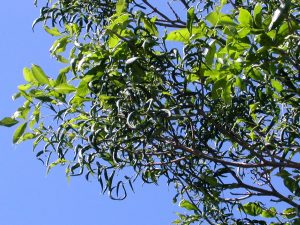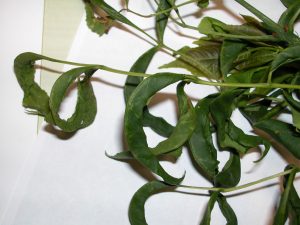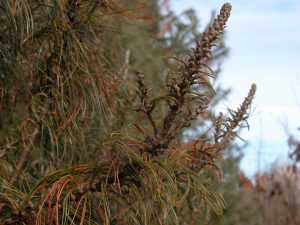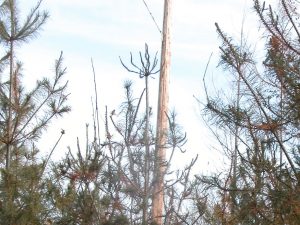Herbicide damage can resemble other tree problems such as branch dieback, foliage discoloration, and premature leaf or needle drop. Look for certain clues to help narrow down whether it is a weather related issue, insect or disease issue, or a potential herbicide issue.

Leaves in the crown are cupped or curled.
What to look for
First, look at all the trees in the area. Does more than one tree species show similar problems? Do all sizes of trees show the problem? If so, the damage may be from herbicides.
Look at the entire tree and pay attention to the foliage.
- Does the tree seem to have less foliage than normal?
- Does any of the foliage look smaller than normal?

Leaves are curled, and look thick and waxy.
- Is the foliage cupped, off color, twisted and/or curled?
- Most importantly, does the foliage look thicker and/or waxier than normal? If so, get a sample and feel it.Herbicide damage will cause the foliage to feel thicker and waxier than normal.
These problems could occur on a single branch, multiple branches, or the entire tree. You may want to compare affected trees to non-affected trees in terms of how they look, and the feel and texture of the foliage.
If the foliage looks normal, look at the branches and twigs.
- If the branches and twigs curl and twist, this is an indication of herbicide damage.
- Abnormal growth can also be caused by herbicides.

Tree showing abnormal growth.

Trees with twisting branches.
Avoiding unintentional damage
The same active ingredient for some herbicides can have different formulations. For example, if you remember the old Garlon 3A product had a triclopyr amine formulation, while the old Garlon 4 product had a triclopyr ester formulation. You need to be aware of which formulation you are using.
Ester formulations can volatize and move at temperatures at or above 85o F, settling around non target plants. I have seen this in Christmas tree plantations where a triclopyr product was used. The temperature reached at least 85o and the product volatized, lifted and settled around other conifers in the plantation. The volatized triclopyr product caused chlorotic rings around the middle of the trees. If temperatures are going to be 85o F or above, you may want to consider using an amine formulation instead of the ester formulation.
If you use “Weed-N-Feed” on your lawn, be careful how much weed-n-feed you apply around your yard trees. Some of the herbicides in these products can and will affect your yard trees and other woody plants.
Before you use any pesticide, make sure to read the label and follow the label directions. The label is Federal Law, and by following the label directions you should avoid any problems that may occur from using the product.
Written by: Todd Lanigan, forest health specialist, Eau Claire,(Todd.Lanigan@wisconsin.gov), 715-839-1632.
